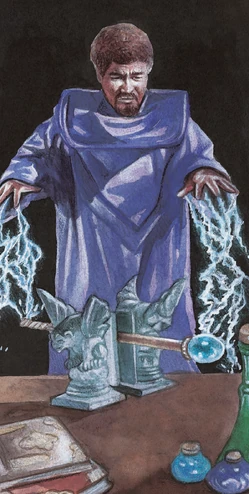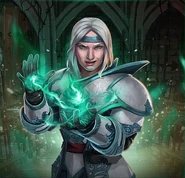
A wizard performing an item enchantment.
The process of item enchantment involved the casting of various spells to imbue an ordinary item with magical properties.[1]
Process[]
In the broadest sense, the steps to create a magical or enchanted item were the design, experimentation, and refinement of a process that would create the desired results. By extension, there was no singular way to create any specific magical item. Even the most simple of enchanted items had a number of different methods to its construction.[1]
Design[]
The first step in crafting a magical item was an initial plan for its function. The mage would research which spells would be necessary to create the desired magical effects in the item being enchanted. The selection of which spells would be most appropriate was never clear-cut, especially this early in the process. An inappropriate choice of spells could prematurely doom an otherwise well-thought-out design.[2]
Some mages would seek deliberate entropy in their item's design, either in an attempt to cull wild magic effects or perhaps as an offering to Mystra. They would include designs for specific, random ingredients to be used, usually in the preparation of the item's shell. Sometimes this would create boons in the item's designs or creation failure in others.[3] So, as in all of magical creation, experimentation was key.[1]
Along with the suitable spells, the focal stones would also be selected and prepared at this stage.[2] These stones were clear or translucent gem stones, to which had been the target of the mage spell of the same name. This would prepare them to hold the magic representative of the item's desired effects.[4]
Primary casting[]
After the desired spells and focal stones had been gathered, the two were linked via dweomerflow spells. This may have been done by the enchanting mage, or outsourced to another spellcaster.[2] The transference of magical energy from the spell to the focal stone occurred either through the caster, from their well of known spells, or directly from another item, using the caster as a bridge.[5]
This differentiation depended on whether the target of dweomerflow was a spellcaster or a magical item. In the case of a targeted spellcaster, it created a resonance field that caused the caster's next spell to have no outward effect and rather flow into the focal stone. When a magical item was targeted, it would transfer its stored spell through the caster and into the focal stone.[5]
The spell abeyance was then cast on the focal stones to ensure the enchantments were held within. The spell magic could only be released, or transferred to another item, via a few other alteration spells.[4] Many enchanters would have scores of focal stones in this state of the process, waiting for months or years until they had the knowledge and resources to fully implement the design of their magical items.[2]
Shell creation[]
Once the focal stones had been created, the physical form of the item had to be planned and accounted for. If the planned item was to be struck with permanency it was pertinent that the majority of the item be composed of more inorganic material, such as stone, metal, or gems, than organic material. The exceptions to this were a few select species of wood native to Faerûn and bone material used in necromantic enchantments. The types of woods that lent themselves to enchantment were oak, ash, thorn, blueleaf, calantra, duskwood, felsul, hiexel, laspar, phandar, shadowtop, silverbark, suth, vundwood, weirwood and zalantar. It was ideal that the wood be gathered from living trees, or to have them entirely felled, by silver-bladed implements. In total, eight substances could be used to create a magical item.[6]
The main inorganic compounds within the non-magical item would ideally have been exposed to the same type of magic as the properties possessed by the finished enchanted product. If that wasn't possible, they should have at least been soaked in tinctures of substances that have been affected by the desired magical, or naturally occurring related, powers. The same went for the items' organic compounds. If they couldn't be gathered or harvested in a magically analogous manner they should at least have been submersed in a potion whose magical effect was similarly associated.[6]
Any substances with a previous dweomer that were to be used for a magical item had to be treated with Azundel's purification, and any tinctures were cleansed with Obar's lesser purification. A cleric could achieve the same effect by use of the higher consecration spell.[6]
After all the physical components to an item were selected, treated and otherwise prepared, each piece was attached by normal means as per the caster's design. Each joint, strap, bolt or other connection was permanently joined with a Merald's meld spell. If four or more substances were used in the same item, a crown meld spell was used to weave all the pieces together, achieving what was known as harmonic fusion.[6] A time stop spell could be cast on any of these melds to prevent decay over if time if, for whatever reason, the enchantment process had to be halted at this step.[7]
Enstarment[]
Once the focal stones were finished, and the physical shell was complete and melded, the process to infuse magical powers into the item could begin. An inorganic surface was used for the enstarment, usually a stone or metal table, and covered with a mystic design. The shell was placed in the center of the design and was encircled by the item's focal stones.[7]
At this point, if the item was to be enchanted with healing or necromantic powers, it would be anointed with a magically purified ointment composed of powdered gems, essential oils, and silver-cut herb. The spells used to cleanse the tincture during the shell's creation, such as Azundel's purification would also be used on the ointment at this step.[7]
The foremost important spell, eternal flame, was cast on the shell, rendering it ready to accept magical enchantments. Either wondrous web or holy vesting was cast next, to link the prepared shell to the focal stones. If the casting was performed well, the shell would radiate a deep blue light and humming lines of light would encircle each focal stone, connect in a larger circle around the shell, and finally extend from each stone to the shell, linking the white light with the blue radiance. Clerics could cast a ritual of transference in place of, or in addition to holy vesting to transfer powers from an altar, artifact, another magical item, or cast spells directly into the shell.[7]
Mastering[]
This step was crucial, and time-sensitive, as it had to be cast before the duration of the wondrous web or holy vesting spells ended. The creator of the item made bare-flesh contact with the shell and spoke the precise specification to which the item would be activated, controlled, or otherwise operated. It was also given a name at this point, if the caster so chose.[8]
If the item was made so as to only operate under the caster's use or command, it was given a truename. This was a specific title, phrase, pet name, or other identifier unique to the caster, so chosen that it was only known to them and not likely discernible by others. If the enchantment was imbued in this manner, it would only function for the person possessing that unique truename.[8]
The pulsing of the shell's radiant energy indicated the success of the mastering step. The focal stones and mystic designs would both fade away and the item would glow bright, turn over, and slowly spin. It would then rest, immobile, and the radiance would fade away, signifying the successful imbuing of magic.[8]
Awakening[]
The last step required was the casting of awakening on the newly created magical item. The less powerful, enchant an item spell could be used, but it had a higher rate of failure.[8]
There were two optional steps after the completion of the enchantment process:
- Veiling, conceal the true appearance of the magical item accomplished with another casting of eternal flame and followed by the necessary illusion spells.[8]
- Permanency, causing the magical power and enchantment of the item to become permanent, and not have its activation based on a set number of charges. Eternal flame would also be recast on the item in this instance followed by the arcane spell permanency or the divine permanency prayer.[8] Evil spellcasters could achieve this process via a blood link, though it would drain the life force of a sentient creature.[9]
Side effects[]
The process of imbuing magic into items took a toll on the body and mind of a spellcaster. The drain on their fortitude with spells like permanency was exceptionally harmful. Due to this, mages who spent too much time crafting magical items were known to become distant, withdrawn, and mentally unstable, while their physical appearance took on a blurred, or shadowy appearance. This was known as spell hollowing. If any mage who had this effect came across the wrong combination of magic they could transform into a wizshade.[1]
Appendix[]
| This article is incomplete. This article needs information from 4th and 5th editions. You can help the Forgotten Realms Wiki by providing more information. |
Gallery[]
References[]
- ↑ 1.0 1.1 1.2 1.3 Ed Greenwood, Eric L. Boyd (1996). Volo's Guide to All Things Magical. (TSR, Inc), p. 13. ISBN 0-7869-0446-1.
- ↑ 2.0 2.1 2.2 2.3 Ed Greenwood, Eric L. Boyd (1996). Volo's Guide to All Things Magical. (TSR, Inc), p. 14. ISBN 0-7869-0446-1.
- ↑ Ed Greenwood, Eric L. Boyd (1996). Volo's Guide to All Things Magical. (TSR, Inc), p. 18. ISBN 0-7869-0446-1.
- ↑ 4.0 4.1 Ed Greenwood, Eric L. Boyd (1996). Volo's Guide to All Things Magical. (TSR, Inc), p. 21. ISBN 0-7869-0446-1.
- ↑ 5.0 5.1 Ed Greenwood, Eric L. Boyd (1996). Volo's Guide to All Things Magical. (TSR, Inc), p. 20. ISBN 0-7869-0446-1.
- ↑ 6.0 6.1 6.2 6.3 Ed Greenwood, Eric L. Boyd (1996). Volo's Guide to All Things Magical. (TSR, Inc), p. 15. ISBN 0-7869-0446-1.
- ↑ 7.0 7.1 7.2 7.3 Ed Greenwood, Eric L. Boyd (1996). Volo's Guide to All Things Magical. (TSR, Inc), p. 16. ISBN 0-7869-0446-1.
- ↑ 8.0 8.1 8.2 8.3 8.4 8.5 Ed Greenwood, Eric L. Boyd (1996). Volo's Guide to All Things Magical. (TSR, Inc), p. 17. ISBN 0-7869-0446-1.
- ↑ Ed Greenwood, Eric L. Boyd (1996). Volo's Guide to All Things Magical. (TSR, Inc), p. 24. ISBN 0-7869-0446-1.

